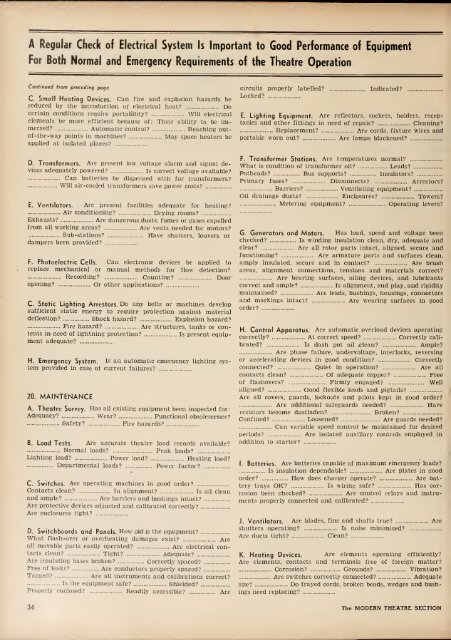Create successful ePaper yourself
Turn your PDF publications into a flip-book with our unique Google optimized e-Paper software.
A Regular Check of Electrical System Is Important to Good Performance of Equipment<br />
For Both Normal and Emergency Requirements of the Theatre Operation<br />
Continued from preceding page<br />
C. Small Heating Devices. Can fire and explosion hazards be<br />
reduced by the introduction of electrical heat? Do<br />
certain conditions require portability? Will electrical<br />
elements be more efficient because of: Their ability to be immersed?<br />
Automatic control? Reaching outof-the-way<br />
points in machines?<br />
May space heaters be<br />
applied at isolated places?<br />
D. Transformers. Are present low voltage alarm and signal devices<br />
adequately powered?<br />
Is correct voltage available?<br />
Can batteries be dispensed with for transformers?<br />
Will air-cooled transformers save power costs?<br />
E. Ventilators. Are present facilities adequate for heating?<br />
Air conditioning?<br />
Drying rooms?<br />
Exhausts?<br />
Are dangerous dusts, fumes or gases expelled<br />
from all working areas? Are vents needed for motors?<br />
Sub-stations? Have shutters, louvers or<br />
dampers been provided?<br />
F. Photoelectric Cells. Can electronic devices be applied to<br />
replace mechanical or manual methods for flow detection?<br />
Recording? Counting? Door<br />
opening?<br />
Or other applications?<br />
C. Static Lighting Arresters. Do any belts or machines develop<br />
sufficient static energy to require protection against material<br />
deflection? Shock hazard? Explosion hazard?<br />
Fire hazard?<br />
Are structures, tanks or contents<br />
in need of lightning protection?<br />
Is present equipment<br />
adequate?<br />
H. Emergency System. Is an automatic emergency lighting system<br />
provided in case of current failures?<br />
20. MAINTENANCE<br />
A. Theatre Survey. Has all existing equipment been inspected for:<br />
Adequacy? Wear? Functional obsolescence?<br />
Safety?<br />
Fire hazards?<br />
B. Load Tests. Ai-e accurate theatre load records available?<br />
Normal loads?<br />
Peak loads?<br />
Ldghting load? Power load? Heating load?<br />
Departmental loads?<br />
Power factor?<br />
C. Switches. Are operating machines in good order?<br />
Contacts clean? In alignment? Is oil clean<br />
and ample?<br />
Are barriers and bushings intact?<br />
Are protective devices adjusted and calibrated correctly?<br />
Are enclosures tight?<br />
D. Switchboards and Panels. How old is the equipment?<br />
What flash-over or overheating damages exist? Are<br />
all movable parts easily operated? Are electrical contacts<br />
clean? Tight? Adequate?<br />
Are insulating bases broken?<br />
Correctly spaced?<br />
Free of leaks?<br />
Are conductors properly spaced?<br />
Tagged? Are all instruments and calibrations correct?<br />
Is the equipment safe?<br />
Shielded?<br />
Properly enclosed? Readily accessible? Aje<br />
circuits properly labelled? Indicated?<br />
Locked?<br />
E. Lighting Equipment. Are reflectors, sockets, holders, receptacles<br />
and other fittings in need of repair? Cleaning?<br />
Replacement?<br />
Are cords, fixture wires and<br />
portable worn out?<br />
Are lamps blackened?<br />
F. Transformer Stations. Are temperatures normal?<br />
What is condition of transformer oil? Leads?<br />
Potheads? Bus supports? Insulators?<br />
Primary fuses? Disconnects? Arrestors?<br />
Barriers?<br />
Ventilating equipment?<br />
Oil drainage ducts? Enclosures? ;... Towers?<br />
Metering equipment?<br />
Operating levers?<br />
G. Generators and Motors. Has load, speed and voltage been<br />
cliecked?<br />
Is winding insulation clean, dry, adequate and<br />
clear? Are all rotor parts intact, aligned, secure and<br />
functioning? Ai-e armature parts and surfaces clean,<br />
amply insulated, secure and in contact? Are brush<br />
areas, alignment connections, tensions and materials correct?<br />
Are bearing surfaces, oiling devices, and lubricants<br />
correct and ample?<br />
Is alignment, end play, and rigidity<br />
maintained?<br />
Are leads, bushings, housings, connectors<br />
and markings intact? Are wearing surfaces In good<br />
order?<br />
H. Control Apparatus. Are automatic overload devices operating<br />
correctly? At correct speed? Correctly calibrated?<br />
Is dash pot oil .clean? Ample?<br />
Are phase failure, undervoltage, interlocks, reversing<br />
or accelerating devices in good condition? Correctly<br />
connected? Quiet in operation? Are all<br />
contacts clean? Of adequate copper? F^ee<br />
of flashovers? Firmly engaged? Well<br />
aligned? Good flexible leads and pigtails?<br />
Ai'e all covers, guards, lockouts and pilots kept in good order?<br />
Are additional safeguards needed? Have<br />
resistors become dustladen? Broken?<br />
Confined? Loosened? Are guards needed?<br />
Can variable speed control be maintained for desired<br />
periods? Are isolated auxiliary controls employed in<br />
addition to starter?<br />
I. Batteries. Are batteries capable of maximum einergency loads?<br />
Is insulation dependable?<br />
Are plates in good<br />
order? How does charger operate? Are battery<br />
trays OK? Is wiring safe? Has corrosion<br />
been checked? Are control relays and instruments<br />
properly connected and calibrated?<br />
J. Ventilators. Are blades, fins and shafts true?<br />
shutters operating? Is noise minimized?<br />
Are ducts tight?<br />
Clean?<br />
K. Heating Devices. Are elements operating efficiently?<br />
Are elements, contacts and terminals free of foreign matter?<br />
Corrosion? Grounds? Vibration?<br />
Are switches correctly connected?<br />
Adequate<br />
size?<br />
Do frayed cords, broken beads, wedges and bushings<br />
need replacing?<br />
Are<br />
34 The MODERN THEATRE SECTION

















